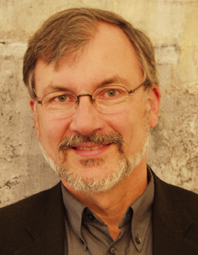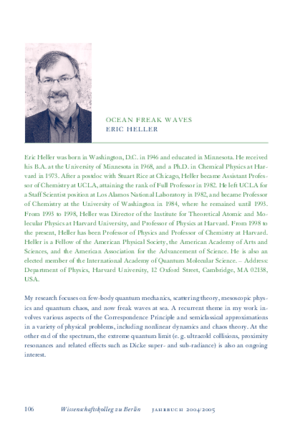
Eric J. Heller, Ph.D.
Professor of Physics
Harvard University
Born in 1946 in Washington DC
Studied Physics at Harvard University
Focus
ImageScience
Project
Studies in Wave Physics and Its History and Visualization
I will be pursuing quantum physics as well as the history of wave physics and its visualization. In addition, I plan to probe the topic of the history of visualization and the use of visual aids in physics and mathematics. Quantum physics and spectroscopy are wellsprings of modern science, at the heart of almost all fields, including nanotechnology, chemistry, and computational devices. I plan to begin a book on time-dependent approaches to quantum spectroscopy in parallel with the visualization studies.Recommended Reading
Most accessible:
Heller, Eric J. "Postmodern Quantum Mechanics." Physics Today 46 (1993): 38.
<br>Heller, Eric J., Mark A. Topinka, and Robert M. Westervelt. "Imaging Electron Flow." Physics Today. December (2003): 47.
Colloquium, 17.05.2005
Seeing the Unseen Wave: Two hundred Years and fourteen Orders of Magnitude
Many phenomena in Nature involve waves we cannot see. For example, sound waves are invisible. More recently, we have discovered the quantum world with its invisible matter waves, the most mysterious of all waves. Most of the electromagnetic spectrum is invisible to us, and even visible light does not present itself to our senses as manifestly a wave. There are other waves that can be seen but we hope never to experience: tsunamis, freak ocean waves, or shock waves from a supersonic event like a large meteor or a bomb.
The Greeks knew that sound traveled as a wave through the sea of air, but it was not until 1800 that the Wittenburg scientist Chladni discovered a way to see sound waves on vibrating glass and metal plates. This work became well known in Europe. Napoleon, a strong supporter of science, saw the demonstration and said "Chladni has made tones visible", which was a perfect way of putting it. His involvement went well beyond this, as I will relate in the talk. The Chladni plates were for many people a mystical connection between the senses and the vibratory world that lies beneath. This mysticism extended to some of the best scientists of the day, such as Oersted, the discoverer of electromagnetism, and the mysticism remains today. The impact of this work has a lot to do with the power of the image, and the notion that "seeing is believing".
While I am not quite so mystical about sound waves, there is no way to avoid the mystery of matter waves, which form the basis of quantum mechanics, an incredibly successful theory. Visualizing matter waves is a large component of what I and other scientists do these days. The talk will wind through the modern era of Eigler's electron wave visualizations, Westervelt's, my own research and images about quantum mechanics.
Finally, the delightful and unexpected connections between electron waves and huge ocean waves (called freak waves) will be explored. This work has occupied much of my time at WIKO. These waves are almost as invisible as the others, since if you see one, you may not live to report it. Such waves were the stuff of lore and fantasy until very recently, when instruments revealed that the sailors tales were true. Once again, seeing is believing, and now there is a scramble to explain why there are so many freak waves, probably 50 of them stalking the seas at the moment you read this.
